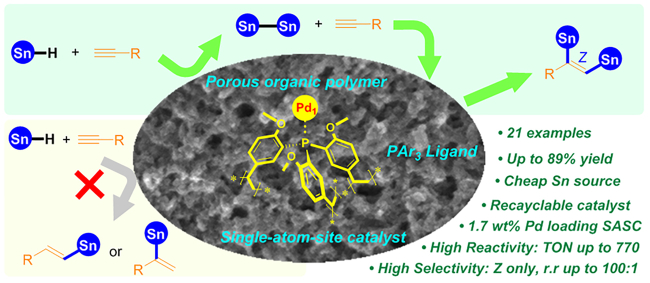Single-atom-site (SAS) catalysts have important applications in electrocatalysis and organic synthesis.
Recently, Prof. DING Yunjie and his colleagues from the Dalian Institute of Chemical Physics of the Chinese Academy of Sciences reported a series of porous organic ligand polymers (POLs) supported SAS Pd catalyst. It showed remarkable catalytic performance in distannylation reactions.
The enrichment of the substrates by the pores, ligand action of the support, and high chemoselectivity and anti-agglomeration of SAS catalysts were the most striking features of this SAS catalyst.
Distannylation of alkynes is very useful in drug synthesis and the construction of complex molecules. In the past, only a few terminal alkynes could be achieved selective distannylation.
Based on the mechanism of this reaction, the researchers designed and prepared the porous organic polymer catalyst with triarylphosphonate as the backbone with advantages including pore enrichment, ligand regulation and single atom selective regulation.
This catalyst solved all the problems in this reaction such as narrow substrate scope, poor selectivity, and low catalytic efficiency.
Different from common carbon-based material, the developed POL support was abundant in phosphate coordination sites with special electrical properties that played a key role in stabilizing the Pd atoms at single atomic sites.
The as-fabricated Pd@POL-5 catalyst displayed superior catalytic activity and selectivity in distannylation of various weak electronically terminal alkynes. The selectivity and catalytic performance were much higher than those of any other heterogeneous or homogenous protocols reported in the literature.

Scientists creates new reaction route for distannylation of terminal alkynes. (Image by WANG Guoqing and JIANG Miao)
This catalytic system offers an effective strategy to use pores, ligands, and single-atom metal sites for synergistic controlling reaction paths.
The study was published in Chem on July 29.(Text by WANG Guoqing and JIANG Miao)